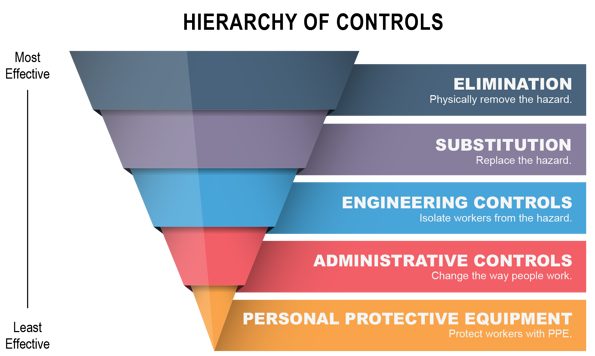Implementing an effective risk control technique requires advance analysis and planning. No one wants to expend resources on a solution that may look good on paper, but once implemented, fails to address the intended risk properly.
As you can see in the graphic below, eliminating hazards that increase the risk of a loss is the most effective risk control technique. Eliminating a hazard could be as simple as changing a driver’s route to avoid a specific hazard or removing a defective piece of equipment from the shop.

CULTURE
Establish a company culture that promotes safety at all levels. Part of this effort includes management’s commitment to evaluating risk control options and considering ways to help eliminate or reduce hazards that may lead to a loss.
COMMUNICATION
Encourage employees to report hazards. Management may not be aware certain hazards exist. Communication up and down the chain of command is key to raising awareness and gathering data essential to finding the proper risk control technique. Including employees in the control techniques selected also helps with their buy-in and support.
ACCOUNTABILITY
Once a risk control technique is implemented, such as wearing PPE or using a machine guard on a piece of equipment in the shop, hold employees accountable for utilizing it.
REWARDS & RECOGNITION
Praise team members for their use and support of risk control measures. Likewise, when the actions taken result in loss reduction, celebrate this achievement. Make it fun. This will encourage ongoing participation in safety initiatives.
CALL TO ACTION
-
Analyze risks to determine which hazards may be eliminated.
-
Conduct regular facility inspections to ensure risk control measures are used.
-
Consider installing fender-mounted mirrors on all tractors as an engineering control to help prevent lane change crashes.
Note: These lists are not intended to be all-inclusive
This material is intended to be a broad overview of the subject matter and is provided for informational purposes only. Joe Morten & Son, Inc. does not provide legal advice to its insureds or other parties, nor does it advise insureds or other parties on employment-related issues, therefore the subject matter is not intended to serve as legal or employment advice for any issue(s) that may arise in the operations of its insureds or other parties. Legal advice should always be sought from legal counsel. Joe Morten & Son, Inc. shall have neither liability nor responsibility to any person or entity with respect to any loss, action, or inaction alleged to be caused directly or indirectly as a result of the information contained herein. Reprinted with permission from Great West Casualty Company.


